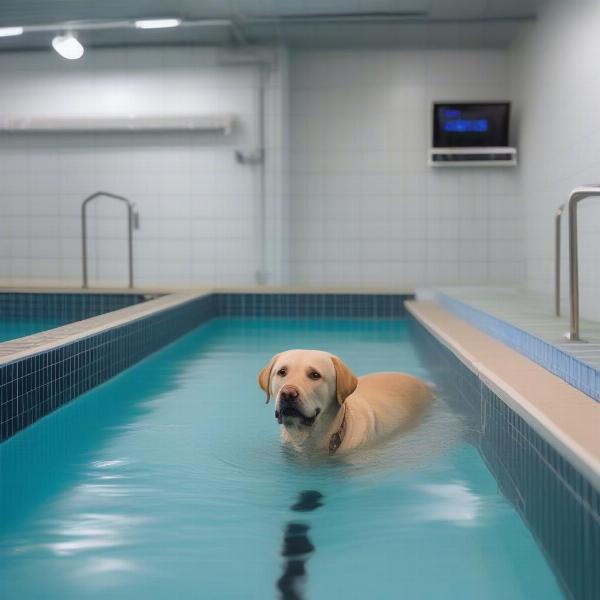Dog water therapy, also known as hydrotherapy or aquatic therapy, offers a range of benefits for dogs of all ages and breeds. It’s a low-impact form of exercise that takes advantage of the buoyancy of water to support joints, build strength, and improve overall well-being. Whether your dog is recovering from an injury, suffering from arthritis, or simply needs a fun way to stay active, dog water therapy can be an excellent option. This comprehensive guide will explore the various aspects of dog water therapy, from its benefits and different types to finding the right facility and ensuring your dog’s safety.
What are the Benefits of Dog Water Therapy?
Water therapy provides a unique environment that reduces stress on joints while allowing for a full range of motion. This makes it an ideal rehabilitation tool for dogs recovering from surgery or injuries, particularly those affecting the limbs, spine, or joints. The buoyancy of water supports the dog’s weight, minimizing pain and allowing them to build strength and improve mobility without putting excessive pressure on injured areas. It’s also beneficial for dogs with chronic conditions like arthritis, hip dysplasia, and other mobility issues.
Beyond rehabilitation, water therapy is also a great way to improve cardiovascular health, build muscle strength, and enhance overall fitness. The resistance of water provides a challenging workout without the impact stress associated with land-based exercises. This makes it suitable for dogs of all ages and fitness levels, from puppies to senior dogs.
 Dog Swimming in a Therapy Pool
Dog Swimming in a Therapy Pool
Different Types of Dog Water Therapy
Dog water therapy can take various forms, including:
- Underwater Treadmills: These specialized treadmills are submerged in water, allowing dogs to walk or run in a controlled environment. The water depth and speed can be adjusted to suit the dog’s individual needs.
- Swimming Pools: Swimming provides a full-body workout that engages all major muscle groups. Dedicated therapy pools are often temperature-controlled and equipped with ramps or steps for easy access.
- Whirlpools and Hydrotherapy Tanks: These provide targeted therapy for specific areas of the body. The warm water and jets can help to reduce inflammation, relieve pain, and promote healing.
Finding the Right Dog Water Therapy Facility
Choosing the right facility for your dog’s water therapy is crucial. Look for a facility with certified and experienced therapists who understand canine anatomy and physiology. Ensure the facility is clean and well-maintained, with appropriate safety measures in place. Ask about the types of therapy offered, the equipment used, and the facility’s protocols for hygiene and sanitation. dog trainers vest
Ensuring Your Dog’s Safety During Water Therapy
While dog water therapy is generally safe, it’s essential to prioritize your dog’s well-being. Make sure your dog is comfortable in the water and that they are supervised at all times by a qualified therapist. Use appropriate flotation devices like life vests, especially for dogs who are not strong swimmers. Monitor your dog for any signs of stress or discomfort and communicate any concerns to the therapist immediately. dog ate a zyn
Conclusion
Dog water therapy can be a highly effective way to improve your dog’s physical and mental well-being. From post-surgery rehabilitation to managing chronic conditions and enhancing overall fitness, water therapy offers a multitude of benefits. By understanding the different types of therapy available, finding a reputable facility, and ensuring your dog’s safety, you can help your furry friend experience the many advantages of dog water therapy. mobile dog grooming tampa fl
FAQ
- Is dog water therapy suitable for all breeds? Yes, most breeds can benefit from water therapy. However, certain breeds with brachycephalic (short-nosed) features may require extra precautions.
- How long does a typical water therapy session last? Sessions typically range from 20 to 60 minutes, depending on the dog’s individual needs and the type of therapy being administered.
- How often should my dog undergo water therapy? The frequency of sessions will depend on your dog’s condition and the therapist’s recommendations.
- Is dog water therapy expensive? The cost of water therapy can vary depending on the facility, the type of therapy, and the length of each session. dog friendly restaurants boise
- Can I perform water therapy on my dog at home? While some simple water exercises can be done at home, it’s essential to consult with a veterinarian or certified canine hydrotherapist before starting any home-based water therapy program. dog goggles
- What should I look for in a qualified canine hydrotherapist? Look for certifications, experience, and a demonstrated understanding of canine anatomy, physiology, and rehabilitation techniques.
- What are the potential risks of dog water therapy? While generally safe, risks can include waterborne illnesses, slips and falls, and potential exacerbation of existing conditions if not managed correctly.
ILM Dog is your trusted international resource for all things dog-related. We offer expert advice and information on dog breeds, health, training, nutrition, grooming, and much more. From choosing the right breed to understanding the nuances of dog water therapy, ILM Dog provides comprehensive resources for dog owners worldwide. Contact us via email at [email protected] or by phone at +44 20-3965-8624. We are here to support you and your furry friend every step of the way.